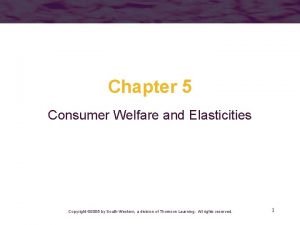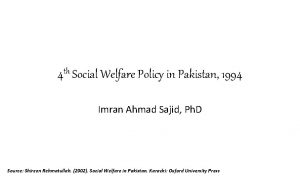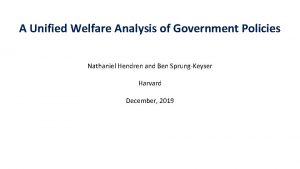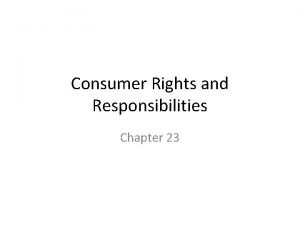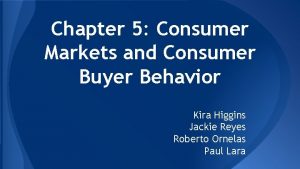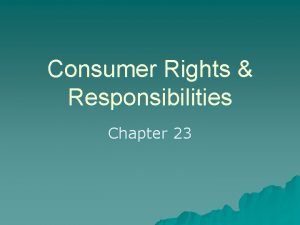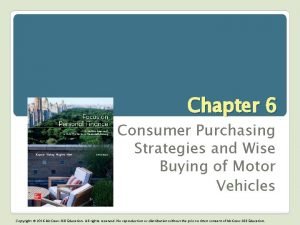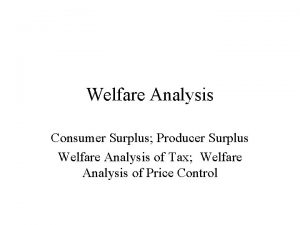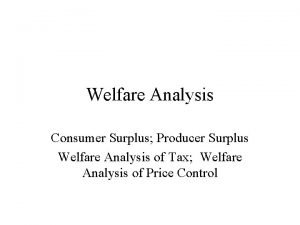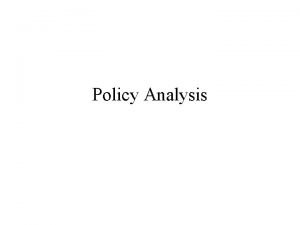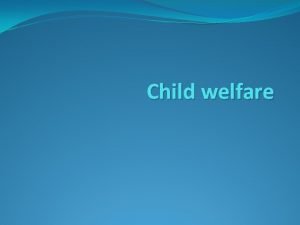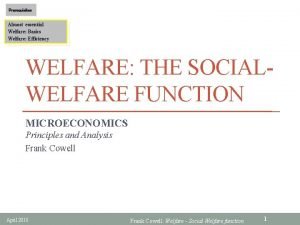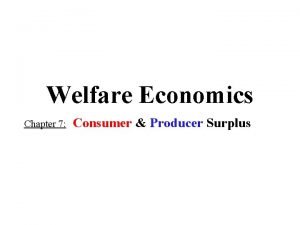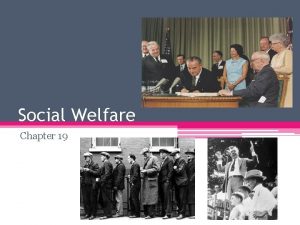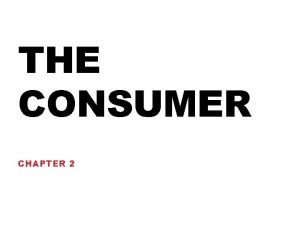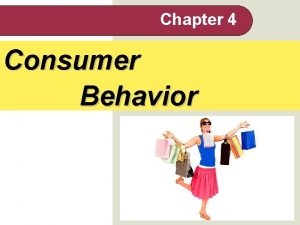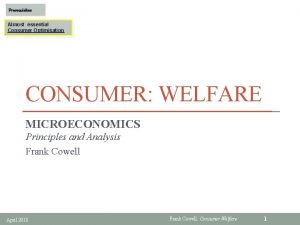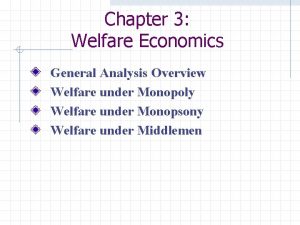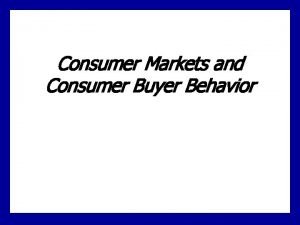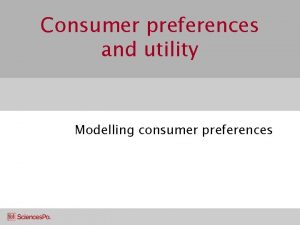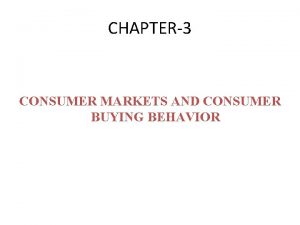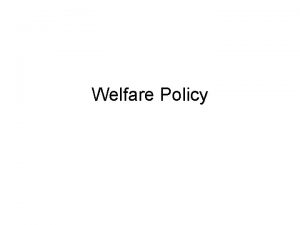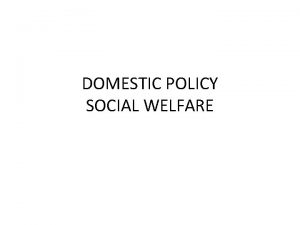Chapter 5 Consumer Welfare and Policy Analysis The






























- Slides: 30

Chapter 5 Consumer Welfare and Policy Analysis The welfare of the people is the ultimate law. Cicero

Chapter 5 Outline Challenge: Child-Care Subsidies 5. 1 Consumer Welfare 5. 2 Expenditure Function and Consumer Welfare 5. 3 Market Consumer Surplus 5. 4 Effects of Government Policies on Consumer Welfare 5. 5 Deriving Labor Supply Curves Challenge Solution Copyright © 2014 Pearson Education, Inc. All rights reserved. 5 -2

Challenge: Child-Care Subsidies • Background: • Government child-care subsidies are common throughout the world. • Rather than subsidizing the price of child care, the government could provide an unrestricted lump-sum payment that could be spent on child care or on all other goods, such as food and housing. • Questions: • For a given government expenditure, does a price subsidy or a lump-sum subsidy provide greater benefit to recipients? • Which option increases the demand for child-care services more? • Which one inflicts less cost on other consumers of child care? Copyright © 2014 Pearson Education, Inc. All rights reserved. 5 -3

5. 1 Consumer Welfare • How much are consumers helped or harmed by shocks that affect the equilibrium price and quantity? • Shocks may come from new inventions that reduce firm costs, natural disasters, or government-imposed taxes, subsidies, or quotas. • You might think utility is a natural measure of consumer welfare. Utility is problematic because: • we rarely know a consumer’s utility function • utility doesn’t allow for easy comparisons across consumers • A better measure of consumer welfare is in terms of dollars. Copyright © 2014 Pearson Education, Inc. All rights reserved. 5 -4

5. 1 Consumer Surplus • Consumer surplus (CS) is the monetary difference between the maximum amount that a consumer is willing to pay for the quantity purchased and what the good actually costs. • Step function Copyright © 2014 Pearson Education, Inc. All rights reserved. 5 -5

5. 1 Consumer Surplus • Consumer surplus (CS) is the area under the inverse demand curve and above the market price up to the quantity purchased by the consumer. • Smooth inverse demand function Copyright © 2014 Pearson Education, Inc. All rights reserved. 5 -6

5. 1 Effect of a Price Change on Consumer Surplus • If the price of a good rises (e. g. £ 0. 50 to £ 1), purchasers of that good lose consumer surplus (falls by A + B) • This is the amount of income we would have to give the consumer to offset the harm of an increase in price. Copyright © 2014 Pearson Education, Inc. All rights reserved. 5 -7

5. 2 Expenditure Function and Consumer Welfare • One measure of the harm to a consumer of a price increase is an increase in the consumer’s income needed to maintain the consumer’s utility. • Cannot use an uncompensated demand curve because utility varies along the curve • Can use compensated demand the expenditure function because both hold utility constant • Recall that the minimal expenditure necessary to achieve a specific utility level and given a set of prices is: • Welfare change associated with price increase to p 1*: Copyright © 2014 Pearson Education, Inc. All rights reserved. 5 -8

5. 2 Expenditure Function and Consumer Welfare • Which level of utility should be used in this calculation? • Two options: • Compensating variation is the amount of money we would have to give a consumer after a price increase to keep the consumer on their original indifference curve. • Equivalent variation is the amount of money we would have to take away from a consumer to harm the consumer as much as the price increase did. Copyright © 2014 Pearson Education, Inc. All rights reserved. 5 -9

5. 2 Compensating Variation and Equivalent Variation • Indifference curves can be used to determine compensating variation (CV) and equivalent variation (EV). Copyright © 2014 Pearson Education, Inc. All rights reserved. 5 -10

5. 2 Three Measures: CS, CV, and EV • Relationship between these measures for normal goods: • |CV| > |∆CS| > |EV| • For small changes in price, all three measures are very similar for most goods. Copyright © 2014 Pearson Education, Inc. All rights reserved. 5 -11

5. 3 Market Consumer Surplus • Market demand is the (horizontal) sum of individual demand curves; market CS is the sum of each individual’s consumer surplus. • CS losses following a price increase are larger: • the greater the initial revenue (p∙Q) spent on the good • the less elastic the demand curve at equilibrium Copyright © 2014 Pearson Education, Inc. All rights reserved. 5 -12

5. 3 Effect of a 10% Price Increase on Consumer Surplus • Revenue and Consumer Surplus in Billions of 2008 Dollars Copyright © 2014 Pearson Education, Inc. All rights reserved. 5 -13

5. 4 Effects of Government Policies on Consumer Welfare • Government programs can alter consumers’ budget constraints and thereby affect consumer welfare. • Examples • Quota: reduces the number of units that a consumer buys • Subsidy: causes a rotation or parallel shift of the budget constraint • Welfare programs: may produce kinks in budget constraint Copyright © 2014 Pearson Education, Inc. All rights reserved. 5 -14

5. 4 Effects of Government Policies • Quotas limit how much of a good consumers can purchase. • Quota of 12 units generates kink in budget line and removes shaded triangle region from individual’s choice set. • EV of this quota is the income reduction (L 2 to L 3) that would move her onto the lower indifference curve, I 2. Copyright © 2014 Pearson Education, Inc. All rights reserved. 5 -15

5. 4 Effects of Government Policies • Welfare programs provide either in-kind transfers or a comparable amount of cash to lowincome individuals. • Example: food stamps • $100 in food stamps (in- kind) generates kinked budget line. • $100 cash transfer increases opportunity set further. Copyright © 2014 Pearson Education, Inc. All rights reserved. 5 -16

5. 4 Effects of Government Policies • Because food stamps can only be used on food, consumers are potentially worse off if they would find it optimal to consume less food and more other goods than allowed by the program. • Despite this, food stamps are used rather than comparable cash transfers in order to: • reduce expenditures on drugs and alcohol • encourage appropriate expenditure on food from a nutrition standpoint • maintain program support from taxpayers, who feel more comfortable providing in-kind rather than cash benefits Copyright © 2014 Pearson Education, Inc. All rights reserved. 5 -17

5. 4 Effects of Government Policies • Subsidies either lower prices or provide lump-sum payments to low-income individuals. • Example: child care subsidy • Reducing price of child care rotates budget line out • Unrestricted lump-sum payment (equal to taxpayers’ cost of the subsidy) shifts budget line out in a parallel fashion and increases opportunity set Copyright © 2014 Pearson Education, Inc. All rights reserved. 5 -18

5. 5 Deriving Labor Supply Curves • Consumer theory is not only useful for determining consumer demand; it is useful for determining consumers’ labor supply decisions. • Labor – Leisure Choice • Work (H = hours) to earn money (w = wage) and buy goods • Don’t work and consume leisure hours, N, and buy goods from unearned income sources, Y* • Utility: • Time constraint: • Total income: • Goal in determining labor and leisure choices is to maximize utility subject to constraints. Copyright © 2014 Pearson Education, Inc. All rights reserved. 5 -19

5. 5 Deriving Labor Supply Curves • Graphical analysis to determine optimal work hours and leisure hours per day: Copyright © 2014 Pearson Education, Inc. All rights reserved. 5 -20

5. 5 Deriving Labor Supply Curves • Graphically, when wage falls, it is optimal to work fewer hours and increase leisure: Copyright © 2014 Pearson Education, Inc. All rights reserved. 5 -21

5. 5 Deriving Labor Supply Curves • Mathematical analysis to determine optimal work hours and leisure hours per day uses calculus to find the tangency point between indifference curve and budget line. • Maximize utility subject to constraints: • First-order condition for an interior maximum is: • Slope of indifference curve = Slope of budget line: Copyright © 2014 Pearson Education, Inc. All rights reserved. 5 -22

5. 5 Deriving Labor Supply Curves • The supply curve for hours worked is the mirror image of the demand curve for leisure hours. Copyright © 2014 Pearson Education, Inc. All rights reserved. 5 -23

5. 5 Income and Substitution Effects • An increase in the wage causes both income and substitution effects. • Total effect of a wage increase is move from e 1 to e 2 (work more). • Substitution effect is e 1 to e* (work more). • Income effect is e* to e 2 (work less). • Thus, substitution effect dominates in this case. Copyright © 2014 Pearson Education, Inc. All rights reserved. 5 -24

5. 5 Leisure is Either an Inferior Good or a Normal Good • With an increase in income, leisure may increase or decrease Copyright © 2014 Pearson Education, Inc. All rights reserved. 5 -25

5. 5 Shape of the Labor Supply Curve • Different effects dominate along different portions of the labor supply curve. • Potentially backward-bending labor supply curve at higher wages Copyright © 2014 Pearson Education, Inc. All rights reserved. 5 -26

5. 5 Income Tax Rates and the Labor Supply Curve • An increase in the income tax rate – a percent of earnings – lowers workers’ after-tax wages and may increase or decrease hours worked. • If labor supply is backward bending, lowering wages through higher income taxes will increase hours worked. • If labor supply is upward sloping, lowering wages through higher income taxes will decrease hours worked. • The effect of imposing a marginal tax rate of is to reduce the effect wage from w to (1 – )w • This rotates a worker’s budget constraint in and downward. Copyright © 2014 Pearson Education, Inc. All rights reserved. 5 -27

5. 5 Income Tax Revenue and Labor Supply • Income tax revenue is , which has a nonlinear relationship to the marginal tax rate: Copyright © 2014 Pearson Education, Inc. All rights reserved. 5 -28

5. 5 Income Tax Revenue and Labor Supply • The government’s tax revenue from an income tax is: • Where is the hours of work supplied by an individual given the after tax wage, . • By differentiating the equation above, we can show income tax revenue changes as the tax rate increases: • Two effects from a change in the marginal tax rate: 1. Government collects more revenue from higher tax rate. 2. Change in tax rate alters hours worked (and direction cannot be predicted by theory alone). Copyright © 2014 Pearson Education, Inc. All rights reserved. 5 -29

Challenge Solution • Child-care subsidy or lumpsum subsidy? • Original budget constraint is LO • If child-care subsidy, budget constraint is LPS. Family chooses e 2 and utility is I 2. • If lump-sum subsidy so that e 2 is affordable, budget constraint is LLS. Family chooses e 3 and utility is I 3. • Taxpayer costs for the two programs are the same, but family is better off with the lump-sum subsidy. Copyright © 2014 Pearson Education, Inc. All rights reserved. 5 -30
 Primary consumer secondary consumer
Primary consumer secondary consumer Cournot aggregation
Cournot aggregation 2nd social welfare policy in pakistan
2nd social welfare policy in pakistan Consumer markets and consumer buyer behavior
Consumer markets and consumer buyer behavior Chapter 5 consumer markets and buyer behavior
Chapter 5 consumer markets and buyer behavior Herbivores in the sahara desert
Herbivores in the sahara desert Cengage
Cengage Consumer research process
Consumer research process Senswex
Senswex Morale welfare and recreation
Morale welfare and recreation Responsibilities of a consumer
Responsibilities of a consumer Chapter 23 consumer rights and responsibilities
Chapter 23 consumer rights and responsibilities Chapter 1 consumer powers and protections
Chapter 1 consumer powers and protections Chapter 5 consumer markets and buyer behavior
Chapter 5 consumer markets and buyer behavior Chapter 23 consumer rights and responsibilities
Chapter 23 consumer rights and responsibilities Chapter 6 consumer purchasing and protection
Chapter 6 consumer purchasing and protection Hát kết hợp bộ gõ cơ thể
Hát kết hợp bộ gõ cơ thể Ng-html
Ng-html Bổ thể
Bổ thể Tỉ lệ cơ thể trẻ em
Tỉ lệ cơ thể trẻ em Gấu đi như thế nào
Gấu đi như thế nào Tư thế worm breton
Tư thế worm breton Hát lên người ơi alleluia
Hát lên người ơi alleluia Môn thể thao bắt đầu bằng từ đua
Môn thể thao bắt đầu bằng từ đua Thế nào là hệ số cao nhất
Thế nào là hệ số cao nhất Các châu lục và đại dương trên thế giới
Các châu lục và đại dương trên thế giới Công thức tiính động năng
Công thức tiính động năng Trời xanh đây là của chúng ta thể thơ
Trời xanh đây là của chúng ta thể thơ Mật thư tọa độ 5x5
Mật thư tọa độ 5x5 101012 bằng
101012 bằng Phản ứng thế ankan
Phản ứng thế ankan

